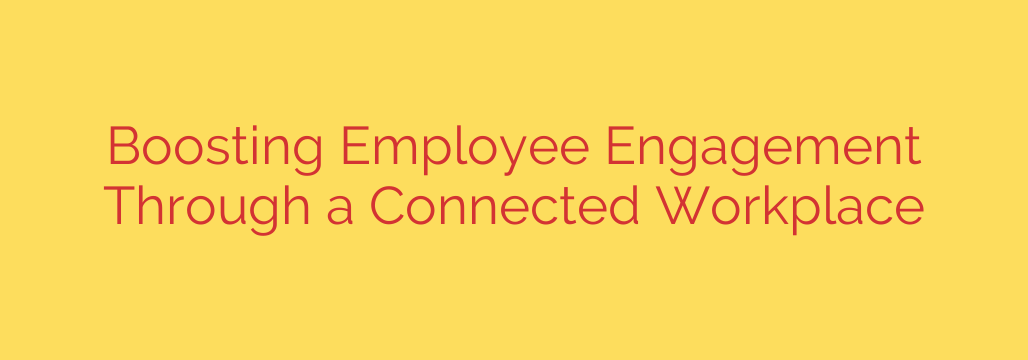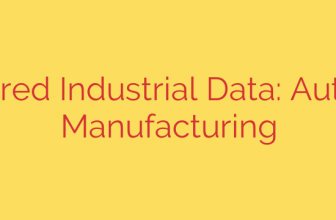
Unlocking Potential: The Link Between a Connected Workplace and Employee Engagement
In today’s competitive landscape, businesses are realizing that their most valuable asset isn’t their product or their technology—it’s their people. Yet, keeping employees motivated, productive, and truly engaged is a persistent challenge. The solution often lies not in grand gestures, but in the digital fabric of the organization itself: the connected workplace.
A truly connected workplace is more than just providing employees with laptops and access to a few software tools. It is a strategic ecosystem where technology, communication, and company culture intertwine seamlessly. When executed correctly, this environment doesn’t just make work easier; it actively boosts employee engagement, enhances innovation, and significantly improves employee retention.
What is a Connected Workplace?
Think of a connected workplace as the digital equivalent of a well-designed physical office. It’s an environment where barriers to communication and collaboration are removed, and information flows freely and securely to those who need it.
Key components include:
- Integrated Communication Tools: Platforms that bring together instant messaging, video conferencing, and project channels to eliminate communication silos.
- Centralized Knowledge Hubs: A single source of truth for company policies, training materials, and important announcements, ensuring everyone is on the same page.
- Seamless Collaboration Software: Tools that allow teams, whether in-office or remote, to co-create, edit, and manage projects in real-time.
- Accessible Digital Resources: Empowering employees with the data, applications, and support they need to perform their roles effectively without unnecessary friction.
4 Powerful Ways Connectivity Supercharges Employee Engagement
Moving from a fragmented set of tools to a truly connected digital environment has a profound impact on how employees feel about their work and the company.
1. It Breaks Down Silos and Fosters True Collaboration
When departments use different systems that don’t communicate, information gets trapped in silos. This leads to frustration, duplicated work, and a sense of isolation between teams. A connected workplace tears down these walls. With integrated platforms, an employee in marketing can easily collaborate with someone in product development, sharing insights and working on documents together in real-time. This cross-functional teamwork not only drives better business outcomes but also makes employees feel like part of a larger, unified mission.
2. It Empowers Employees with Information and Autonomy
Nothing disengages an employee faster than feeling powerless or uninformed. A connected environment puts essential information directly into the hands of your team. When employees can easily find the data they need, access training modules on their own time, and stay updated on company-wide goals, they feel trusted and empowered. This autonomy is a critical driver of job satisfaction and encourages proactive problem-solving.
3. It Enhances Flexibility for Modern Work Models
The rise of remote and hybrid work has made a connected workplace essential. For distributed teams to succeed, they need a digital headquarters that provides the same level of access and camaraderie as a physical office. A well-designed connected ecosystem ensures that remote employees are just as included, informed, and engaged as their in-office counterparts. This digital parity is key to maintaining a strong company culture and supporting a healthy work-life balance.
4. It Strengthens Company Culture and Recognition
Company culture can be difficult to maintain when teams are physically separated. Digital platforms in a connected workplace can become powerful tools for reinforcing culture. Use them to create dedicated channels for employee recognition, celebrate team wins, share success stories, and host virtual social events. When employees feel seen, appreciated, and connected to their colleagues on a personal level, their loyalty and engagement skyrocket.
Building Your Connected Workplace: Actionable Steps
Creating this environment requires a thoughtful strategy, not just a technology budget.
- Audit Your Existing Technology: Identify points of friction. Are employees forced to switch between too many different applications? Are there redundant tools?
- Prioritize the Employee Experience: When choosing new software, ask: Is it intuitive? Does it solve a real problem for our team? A complicated tool will only create new frustrations.
- Establish a Central Hub: Invest in a core platform, like a modern intranet or a comprehensive collaboration tool (e.g., Microsoft Teams or Slack), to serve as the “digital front door” for your organization.
- Train Your Team: Don’t just launch a new tool and expect adoption. Provide thorough training and clearly communicate the benefits to ensure everyone knows how to use the systems effectively.
A Critical Note on Cybersecurity
As you increase connectivity, you also expand your potential security vulnerabilities. A connected workplace must be a secure one. It is crucial to implement robust security measures to protect both company and employee data.
Essential Security Tips:
- Enforce Multi-Factor Authentication (MFA): This is one of the most effective ways to prevent unauthorized access to accounts and systems.
- Conduct Regular Security Training: Educate employees on how to spot phishing attempts, use strong passwords, and handle sensitive information securely.
- Utilize Company-Approved Platforms: Discourage the use of unauthorized, third-party apps for work-related communication and file sharing to maintain control over your data.
Ultimately, investing in a connected workplace is an investment in your people. It’s about creating an environment where employees feel informed, empowered, and valued—the very foundation of sustainable business success.
Source: https://collabnix.com/creating-a-connected-workplace-that-boosts-employee-engagement-2/








